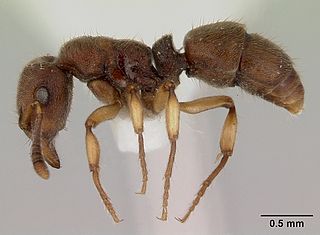
The smalleye catshark is a species of shark beloning to the family Pentanchidae, the deepwater catsharks. This shark is found in the southeast Atlantic at depths between 700 and 2,000 m. It can grow up to 61 cm. The reproduction of this catshark is oviparous.

The Metopininae are a subfamily of flies in the family Phoridae.

Heteroponera is a genus of ants in the subfamily Ectatomminae. The genus is known from the Neotropics and Australasia.

Neivamyrmex is a genus of army ants in the subfamily Dorylinae.
Heteroponera angulata is a species of ant in the genus Heteroponera, endemic to Brazil. It was described by Borgmeier in 1959.

Diplonevra is a genus of scuttle flies. There are at least eight described species in Diplonevra.

Pseudacteon is a genus of flies in the family Phoridae. There are over 70 described species of Pseudacteon fly. They are also known as ant-decapitating flies due to their parasitic larval stage. An egg is injected by the female fly into the shoulder joint of an ant worker. Soon after, the egg undergoes rapid inflation as it appears to absorb ant hemolymph. This first instar larva migrates into the ant head and consumes the jaw muscle and other tissues, leaving the mandibles hanging and preparing a future exit space. After about two weeks, the ant worker is termed a "zombie" because the fly larva has effectively taken control. The worker leaves the nest and dies in the leaf litter or in a crack in the soil. As it dies, the ant's head falls off, apparently because the fly larva releases an enzyme that dissolves the membrane attaching the ant's head to its body. The fly pupates in the detached head capsule, requiring a further two weeks before emerging through the ant's mouth. In tropical, subtropical areas the flies are active all year round, but in temperate regions they are active during all months except the winter months. Several Pseudacteon species were deliberately introduced to the United States to combat via biological control the invasive fire ant species Solenopsis invicta.

Phalacrotophora is a genus of scuttle flies. There are at least 50 described species in Phalacrotophora.
Thomas Borgmeier was a German-Brazilian priest and entomologist and became a specialist on the ants of Brazil and on the flies in the family Phoridae. He was also the founder of the journals Revista de Entomologia edited it from 1931 to 1951 and the Studia Entomologica from 1958.

The Metopininae is a tribe of flies in the family Phoridae.
Acanthophorides is a genus of flies in the family Phoridae.
Cremersia is a genus of flies in the family Phoridae.
Commoptera is a genus of flies in the family Phoridae.
Ecitomyia is a genus of flies in the family Phoridae.
Ecitoptera is a genus of flies in the family Phoridae.
Metopina is a genus of flies in the family Phoridae.
Myrmosicarius is a genus of flies in the family Phoridae.
Xanionotum is a genus of flies in the family Phoridae.

Aenigmatias is a genus of flies in the family Phoridae.








